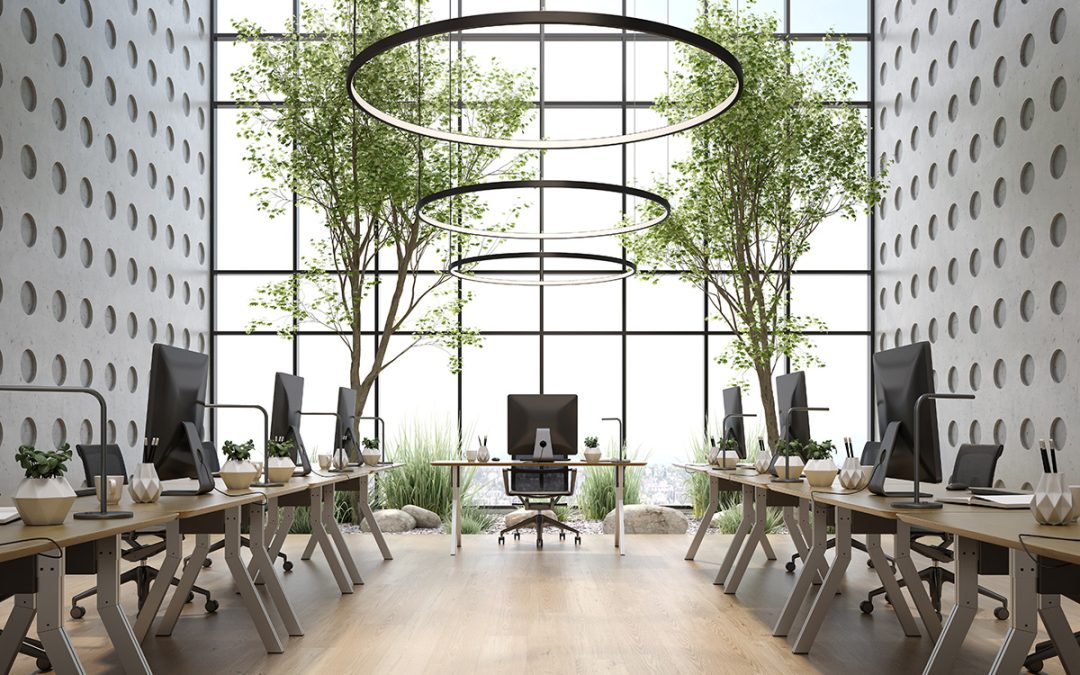In today’s fast-paced, technology-driven world, businesses are constantly seeking innovative ways to improve employee productivity, foster creativity, and create environments that attract and retain top talent. Biophilic design—an approach that integrates elements of nature into the built environment—has emerged as a powerful solution to these challenges. By fostering a connection between people and the natural world, biophilic design enhances workplace well-being, boosts performance, and provides a competitive edge in an increasingly crowded marketplace.
What is Biophilic Design?
Biophilic design is rooted in the concept of biophilia, a term popularized by biologist Edward O. Wilson, which describes humans’ innate affinity for nature. This design philosophy seeks to incorporate natural elements such as greenery, sunlight, water features, and organic materials into man-made spaces. Beyond aesthetics, biophilic design emphasizes functionality, creating environments that promote physical and mental health while enhancing productivity and creativity.
The Business Case for Biophilic Design
Investing in biophilic design is more than an environmental statement; it is a strategic business decision. Here’s why it matters for businesses:
1. Improved Employee Well-being
The well-being of employees is a top priority for forward-thinking businesses, and biophilic design has been proven to positively impact mental and physical health. Exposure to natural elements reduces stress, lowers blood pressure, and enhances mood. A study by the Human Spaces Report found that employees in offices with natural elements reported a 15% higher level of well-being compared to those in traditional office spaces.
For businesses, healthier employees mean fewer sick days, lower healthcare costs, and increased overall morale. Biophilic spaces can also reduce symptoms of “sick building syndrome,” a condition often caused by poor indoor air quality and artificial lighting.
2. Enhanced Productivity and Creativity
Biophilic design doesn’t just make workplaces look better; it helps employees work better. Natural light, for instance, has been shown to improve focus and energy levels. Employees working in daylight-filled offices are more productive and report higher job satisfaction. Similarly, access to green spaces or indoor plants can spark creativity, improve cognitive function, and reduce mental fatigue.
Businesses that integrate biophilic design often experience better performance outcomes. A 2014 study revealed that workers in biophilic office environments were 6% more productive and 15% more creative than those in conventional settings.
3. Attracting and Retaining Talent
In a competitive job market, a thoughtfully designed workplace can be a powerful recruitment and retention tool. Biophilic design creates a unique and inviting environment that appeals to prospective employees, particularly Millennials and Gen Z, who prioritize workplace wellness and sustainability.
Offering biophilic elements like rooftop gardens, living walls, or water features demonstrates a company’s commitment to employee well-being and environmental responsibility. This can help businesses stand out to job seekers and foster long-term loyalty among existing staff.
4. Reduced Operational Costs
While biophilic design may involve an upfront investment, it can lead to significant cost savings over time. Natural lighting and ventilation can reduce energy consumption, cutting utility bills. Plants and green walls improve indoor air quality, reducing the need for expensive air purification systems.
Moreover, by boosting employee productivity and reducing absenteeism, biophilic design delivers a measurable return on investment. For example, improved performance and lower turnover rates can offset the costs of implementing natural features in the workplace.
5. Enhanced Brand Image and Customer Experience
Biophilic design isn’t just for employees—it can also create a positive impression on clients and customers. Businesses that incorporate natural elements into their spaces project an image of innovation, sustainability, and care for the environment. For customer-facing businesses like retail stores, hotels, or restaurants, biophilic design enhances the customer experience, encouraging longer visits and increased spending.
Studies show that consumers are drawn to environments with natural features, finding them more relaxing and inviting. Retail spaces with biophilic design elements, such as greenery or water features, often see higher sales and customer satisfaction.
Practical Applications of Biophilic Design in Business
Biophilic design can be implemented in a variety of ways, from simple adjustments to comprehensive renovations. Here are some practical strategies businesses can adopt:
1. Incorporate Greenery
- Add indoor plants, vertical gardens, or moss walls to office spaces.
- Create outdoor spaces like rooftop gardens or courtyards for employees and clients to enjoy.
2. Maximize Natural Light
- Use large windows, skylights, or glass partitions to bring in sunlight.
- Arrange workspaces to take advantage of natural light sources.
3. Use Natural Materials
- Opt for furniture, flooring, and finishes made from wood, stone, or bamboo.
- Include textiles and artwork inspired by natural patterns and colors.
4. Integrate Water Features
- Add fountains, aquariums, or other water elements to create a calming atmosphere.
- Use soundscapes of running water to enhance relaxation.
5. Design for Comfort and Flexibility
- Incorporate biophilic principles into quiet zones, collaboration areas, and break rooms.
- Use open layouts and organic shapes to mimic the flow of natural landscapes.
Case Studies: Biophilic Design in Action
1. Amazon Spheres
Amazon’s headquarters in Seattle features three glass-enclosed spheres filled with over 40,000 plants from around the world. These spaces provide employees with a tranquil environment to work, meet, and relax, fostering creativity and innovation.
2. Google’s Offices
Google’s offices are renowned for their biophilic design elements, including indoor gardens, rooftop terraces, and abundant natural light. These features align with Google’s commitment to employee well-being and sustainability.
3. Changi Airport, Singapore
Changi Airport is a prime example of how biophilic design can enhance the customer experience. The airport features lush indoor gardens, a waterfall, and open-air spaces, creating a relaxing environment for travelers.
Conclusion
Biophilic design is more than just a design trend—it’s a strategic approach that delivers tangible benefits for businesses. By integrating natural elements into the workplace, companies can improve employee well-being, enhance productivity, attract and retain talent, and boost their brand image. As businesses continue to prioritize sustainability and innovation, biophilic design will play an increasingly vital role in shaping the future of workspaces and customer experiences.

